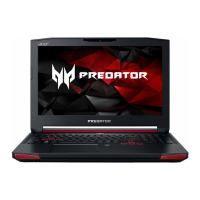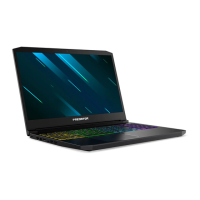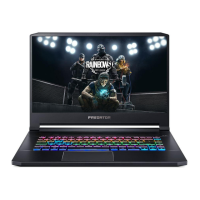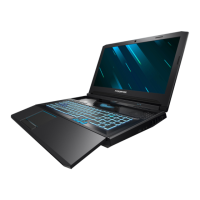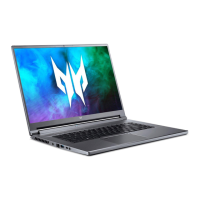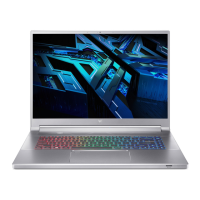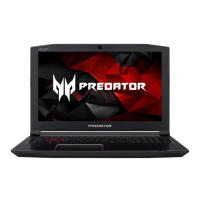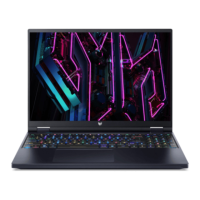Do you have a question about the Acer Predator 21 X and is the answer not in the manual?
Encourages users to create an Acer ID for enhanced benefits and account features.
Details the various guides available to help users set up and use their Predator notebook.
Provides essential advice on maintaining and operating the computer safely and effectively.
Explains the use of dual AC adapters for optimal performance and power delivery.
Outlines the steps for safely cleaning the computer and when to seek professional servicing.
Identifies and describes the components visible on the computer's screen assembly.
Details the layout and functions of the computer's keyboard and associated keys.
Illustrates and describes the ports and features located on the front of the notebook.
Identifies and explains the ports and ventilation on the left side of the notebook.
Provides specific details and guidelines for using USB 3.0 ports and devices.
Details the ports and ventilation features located on the right side of the notebook.
Illustrates and describes the ports and ventilation on the rear of the notebook.
Offers specific information and capabilities of the USB Type-C port.
Identifies and describes components and features visible on the bottom of the notebook.
Explains the function and operation of the Caps Lock, Num Lock, and Scroll Lock keys.
Describes the use of function keys (Fn key combinations) for system controls.
Details the functions of specific keys dedicated to Windows operating system features.
Instructions for replacing standard keycaps with alternative gaming-focused ones.
Explains the functionality and installation of the reversible touchpad/keypad module.
Details various gestures recognized by the precision touchpad for navigation and control.
Guides users through modifying touchpad sensitivity, behavior, and preferences.
Describes the hardware components involved in the Tobii Eye Tracking system.
Provides instructions for initial setup and calibration of the eye tracking system.
Covers advanced configuration options for the eye tracking system, which may differ by model.
Explains how eye tracking can be used to enhance gaming and other user experiences.
Details how to configure security, touchpad, and mouse settings using eye tracking.
Describes the Gaze Trace feature for checking system calibration and user focus.
Guides on creating, managing, and recalibrating user profiles for the eye tracking system.
Offers advice for optimal eye tracking performance and where to find additional support.
Step-by-step guide to create a factory default backup for system recovery.
Instructions for backing up wireless and LAN drivers for reinstallation.
Explains how to restore the computer to its default status using recovery tools.
Guides on resetting the PC while preserving personal files and data.
Instructions for a complete system reset, removing all personal files, apps, and settings.
Details how to turn the Bluetooth adapter on and off on the computer.
Steps for pairing new Bluetooth devices with the computer for connectivity.
Guides on establishing an internet connection via a wireless local area network (WLAN).
Explains how to connect to the internet using a wired network cable (Ethernet).
Information on using a SIM card and cellular network for internet access.
Overview of the main interface and system status monitoring within PredatorSense.
Details on using PredatorSense to boost CPU and GPU performance through overclocking.
Guides on configuring various system settings and features within the PredatorSense application.
Instructions for customizing the color and effects of the keyboard's LED backlighting.
Explains how to use animated lighting effects for the keyboard and system LEDs.
Details how to customize lighting for specific zones like the logo, light bar, and power button.
Guides on assigning custom functions and macros to programmable hotkeys.
Instructions for creating and managing profiles for hotkeys and lighting schemes.
Explains how to manage fan speeds for CPU, GPU, and system cooling via PredatorSense.
Describes how to monitor system temperatures, loading, and fan speeds using PredatorSense.
Details the Low Reduction mode for reducing blue light emissions from the screen.
Explains the Medium Reduction mode for eye protection against blue light.
Describes the High Reduction mode for maximum protection against blue light.
Details the Long Hour Mode for reducing eye strain during extended use.
Explains how to use the physical security slot for a computer lock.
Details different types of passwords (Supervisor, User, Boot) for system security.
Describes the process of entering passwords for BIOS and system access, including attempts.
Guides on how to configure the computer's boot sequence within the BIOS utility.
Instructions for setting BIOS passwords (Supervisor, Password on Boot) for enhanced security.
Provides methods to conserve battery power and reduce energy consumption.
Instructions on how to turn off the fast startup feature to manage power usage.
Describes the Lithium battery, its charging capabilities, and usage patterns.
Details the process of connecting the AC adapter to charge the computer's battery.
Explains the initial conditioning process for new battery packs to maximize performance.
Offers tips and suggestions to prolong battery operation and efficiency.
Explains how to view the current battery charge level on the taskbar.
Provides guidance on actions to take when the battery power is critically low.
Step-by-step guide on safely disconnecting external accessories before moving the computer.
Tips for moving the computer over short distances, e.g., within an office.
Instructions on preparing the computer for transport, including sleep mode and shutdown.
Advice on necessary items to bring for meetings, considering battery life and power availability.
Guidance on transporting the computer between home and office environments.
Lists essential items to carry when traveling with the computer.
Provides guidelines for protecting the computer from temperature changes and physical damage during travel.
Specific advice and precautions for traveling with the computer across country borders.
Information on connecting multiple displays via the Thunderbolt 3 port.
Step-by-step instructions for properly inserting an SD card into the reader.
Details the different types and capacities of SD cards supported by the reader.
Explains how to connect audio devices like headphones, speakers, and microphones.
Outlines the conditions and restrictions for ordering and applying custom computer panels.
Provides step-by-step instructions for installing a new custom computer panel.
Troubleshooting steps for computer power, boot-up, and blank screen problems.
Resolves problems with sound output, keyboard responsiveness, and printer functionality.
Guides on system recovery, warranty information, and how to request service.
Tips for using Windows 10 features like Start menu, app management, and notifications.
Customizing lock screen, setting up slideshows, and arranging tiles in Windows.
Finding apps, pinning them to Start/taskbar, and checking for Windows updates.
General advice and strategies for diagnosing and resolving common system issues.
Lists common error messages and their corresponding corrective actions for system problems.
Guides on choosing an ISP, connection types, and wireless network setup.
Advice on preventing fraud, keeping software updated, and using security tools.
| Processor | Intel Core i7-7820HK |
|---|---|
| RAM | 64GB DDR4 |
| Operating System | Windows 10 Home |
| Display | 21-inch curved IPS, 2560 x 1080 resolution |
| Graphics | NVIDIA GeForce GTX 1080 SLI |
| Storage | 1TB HDD |
| Weight | 8.5 kg |
| Keyboard | Mechanical keyboard with Cherry MX switches |
| Trackpad | Precision touchpad, numeric keypad mode |
| Audio | 4 speakers + 2 subwoofers, Dolby Audio |
| Ports | HDMI, Ethernet, SD card reader |
| Battery | 8-cell battery |

